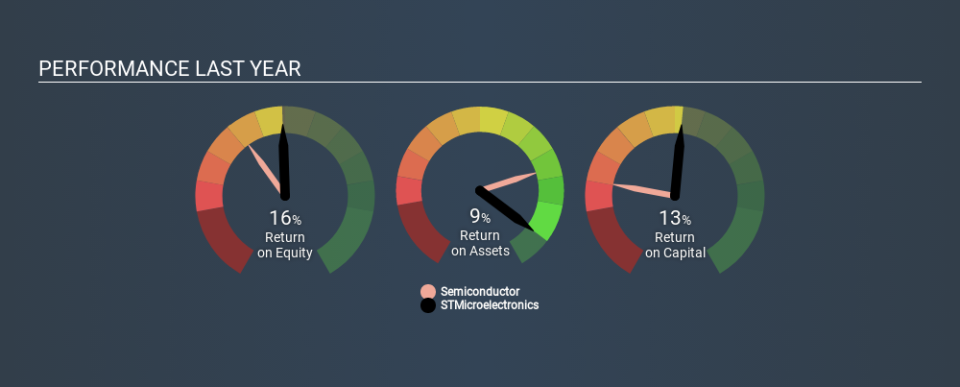Evaluating STMicroelectronics N.V.’s (EPA:STM) Investments In Its Business

Today we'll look at STMicroelectronics N.V. (EPA:STM) and reflect on its potential as an investment. In particular, we'll consider its Return On Capital Employed (ROCE), as that can give us insight into how profitably the company is able to employ capital in its business.
First of all, we'll work out how to calculate ROCE. Second, we'll look at its ROCE compared to similar companies. Finally, we'll look at how its current liabilities affect its ROCE.
What is Return On Capital Employed (ROCE)?
ROCE measures the 'return' (pre-tax profit) a company generates from capital employed in its business. All else being equal, a better business will have a higher ROCE. Overall, it is a valuable metric that has its flaws. Author Edwin Whiting says to be careful when comparing the ROCE of different businesses, since 'No two businesses are exactly alike.
How Do You Calculate Return On Capital Employed?
Analysts use this formula to calculate return on capital employed:
Return on Capital Employed = Earnings Before Interest and Tax (EBIT) ÷ (Total Assets - Current Liabilities)
Or for STMicroelectronics:
0.13 = US$1.2b ÷ (US$12b - US$2.1b) (Based on the trailing twelve months to September 2019.)
Therefore, STMicroelectronics has an ROCE of 13%.
Check out our latest analysis for STMicroelectronics
Is STMicroelectronics's ROCE Good?
When making comparisons between similar businesses, investors may find ROCE useful. We can see STMicroelectronics's ROCE is around the 11% average reported by the Semiconductor industry. Independently of how STMicroelectronics compares to its industry, its ROCE in absolute terms appears decent, and the company may be worthy of closer investigation.
We can see that, STMicroelectronics currently has an ROCE of 13% compared to its ROCE 3 years ago, which was 2.5%. This makes us think the business might be improving. The image below shows how STMicroelectronics's ROCE compares to its industry, and you can click it to see more detail on its past growth.
It is important to remember that ROCE shows past performance, and is not necessarily predictive. ROCE can be deceptive for cyclical businesses, as returns can look incredible in boom times, and terribly low in downturns. ROCE is only a point-in-time measure. Future performance is what matters, and you can see analyst predictions in our free report on analyst forecasts for the company.
STMicroelectronics's Current Liabilities And Their Impact On Its ROCE
Short term (or current) liabilities, are things like supplier invoices, overdrafts, or tax bills that need to be paid within 12 months. Due to the way the ROCE equation works, having large bills due in the near term can make it look as though a company has less capital employed, and thus a higher ROCE than usual. To counter this, investors can check if a company has high current liabilities relative to total assets.
STMicroelectronics has total liabilities of US$2.1b and total assets of US$12b. As a result, its current liabilities are equal to approximately 18% of its total assets. Low current liabilities are not boosting the ROCE too much.
What We Can Learn From STMicroelectronics's ROCE
With that in mind, STMicroelectronics's ROCE appears pretty good. STMicroelectronics shapes up well under this analysis, but it is far from the only business delivering excellent numbers . You might also want to check this free collection of companies delivering excellent earnings growth.
If you like to buy stocks alongside management, then you might just love this free list of companies. (Hint: insiders have been buying them).
If you spot an error that warrants correction, please contact the editor at editorial-team@simplywallst.com. This article by Simply Wall St is general in nature. It does not constitute a recommendation to buy or sell any stock, and does not take account of your objectives, or your financial situation. Simply Wall St has no position in the stocks mentioned.
We aim to bring you long-term focused research analysis driven by fundamental data. Note that our analysis may not factor in the latest price-sensitive company announcements or qualitative material. Thank you for reading.

 Yahoo Finance
Yahoo Finance 
